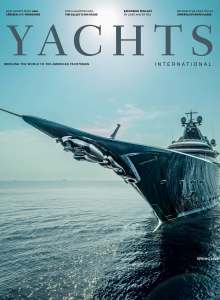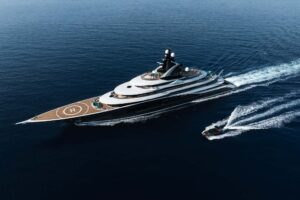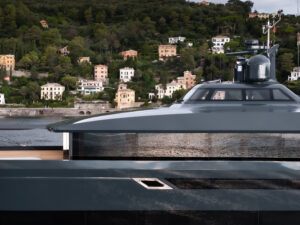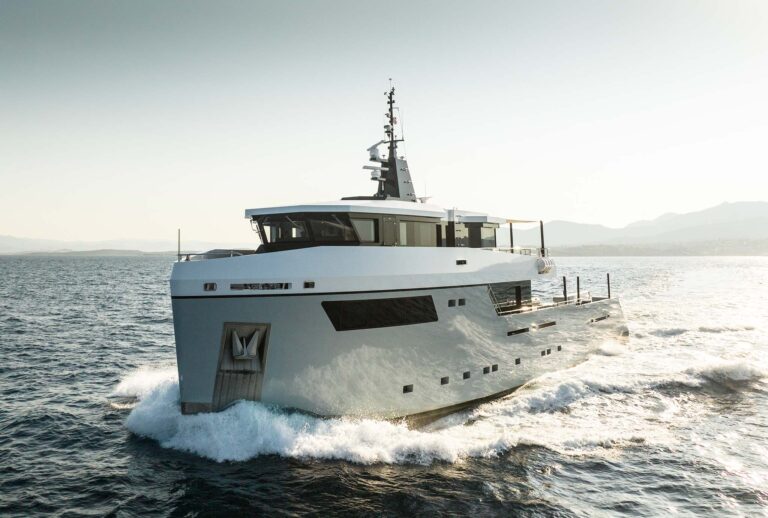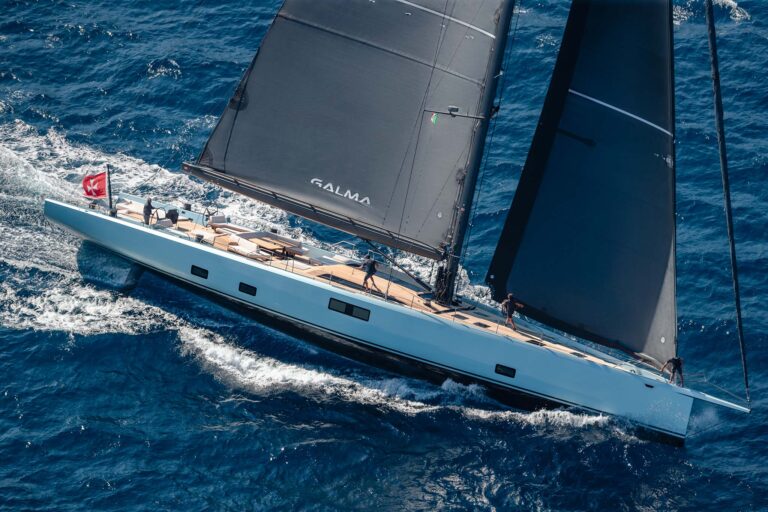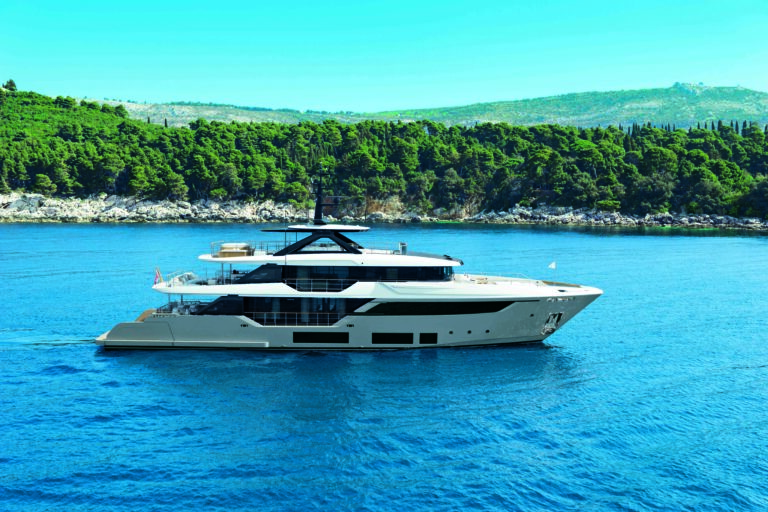Story Nick Boksa, PE
Over the last six years or so, pod drive propulsion has become an exciting option for owners, builders and designers seeking more efficient ways to power their yachts. The benefits of pod drives—maneuverability, operational efficiency and design flexibility—have proven irresistible within the industry.
They have quickly replaced traditional shaft-drive systems as a standard option on many small and midsize production boats. They are also being added to increasing numbers of designs from builders of larger sportfishing boats and semi-custom cruising yachts in the 50- to 90-plus-foot range.
From our perspective as naval architects and engineers, it’s only a matter of time before pod drive systems will be commonly found on luxury motoryachts and superyachts between 100 and 300 feet.
Pods defined

While most owners and operators of yachts are familiar with pod drive propulsion systems, their growing application is still relatively new within the industry. Briefly, pods are underwater drive systems located on the bottom of a vessel’s hull. The units rotate to provide propulsion in nearly all directions, giving full control to the operator. Pod drives are linked to the engines either through a direct mechanical link or in a diesel-electric arrangement. In the diesel-electric arrangement, the engines turn generators that provide electricity to motors linked to the pod drives.
Pod propulsion systems eliminate the need for conventional rudders, steering gear, propellers, struts and shafts. The props are part of the pod unit. No longer is the transmission connected to the propellers by a long angled shaft.
With a pod drive system, the connection is electric wiring. In vessels equipped with diesel-electric engines, this allows the owner, designer or builder to decide where to locate the engines. This flexibility allows freeing up extra cabin space and provides options for buoyancy and weight distribution.
Thrust from pods is horizontal, meaning that 100 percent of the thrust goes to driving the boat forward. This creates significant operational efficiency over traditional systems that tend to waste thrust vertically due to the angle of the inclined shaft. Some pod manufacturers report a 15 to 20 percent increase in efficiency.
The ability to control the direction of the pod’s thrust also provides operators with full control over the direction of the vessel’s movement. Operators can spin the vessel on its axis and move side to side at any angle. This is quite beneficial for maneuverability.
Owners and crew may also enjoy dynamic positioning, which allows holding the position of the boat steady while waiting for bridges to open or maintaining position while loading and unloading tenders.
A few owners understand the potential drawbacks of pod technology, including initial higher purchase costs and maintenance costs. Pods are complicated systems and there are currently fewer resources—both in terms of personnel and boatyards—that specialize in pod maintenance.
While pod propulsion systems offer many more pros than cons, the decision to utilize them is based on owners’ preferences, the vessel’s intended use and overall design. Your designer or builder can help you make the right decision as to which system is correct for you.
Pods’ higher power

The long list of benefits is changing the game with luxury motoryachts in all sizes. Pod drive propulsion systems already power big boats, as they have large commercial vessels, including cruise ships, ferries and tugboats for some time. Commercial vessels benefit from the control, precision of movement and fuel efficiency that pod systems provide.
All of the benefits that smaller recreational boats and larger commercial vessels realize with pods systems can also improve the operation and overall efficiency of larger yachts. In reality, the concept is the same. Large yachts and superyachts, like cruise ships, are displacement vessels that can be powered more efficiently by pods. Hydrodynamically, they are more efficient—generally upward of 15 percent—which translates to decreased fuel consumption and emissions, as well as potential weight savings. Fuel savings can reach as much as 30 percent, depending on design and usage.
The only real difference is in the kind of engines and pods larger yachts require. Vessels smaller than 100 feet are generally powered by Volvo Penta IPS and the ZF Zeus pod propulsion (the most popular design applications are found on boats in the 30- to 50-foot range, although they can power crafts from 30 to 100 feet).
To drive larger yachts, pod drive systems need to accept more powerful input from larger engines. Potential systems for luxury yachts (which have already been used in a few cases) include the Rolls-Royce Mermaid Pod Propulsion System, the ABB Azipod Propulsion System and others.
These commercial class systems are the solutions architects need to design superyachts with pod technology.
Owners drive the demand

The main driver of change within the last few years is the market itself. Owners who have enjoyed the benefits of pod drives on smaller vessels are pushing naval architects and builders to find ways to apply pod technology to other boats, specifically larger sportfishing boats, semi-custom production yachts and fully customized luxury yachts.
Owners recognize and appreciate the list of benefits that pod driven systems deliver. Those benefits are also evident to the designers who work closely with owners to ensure that their boats reflect their operating requirements.
Both the owner and the designer will tell you that the key benefit to pod drives is their impact on the boat’s maneuverability. For large, crewed yachts it’s less of an issue but for owner-operated boats, the difference is unmatchable. Builders, quite adept at producing boats that potential customers want to purchase, have already included pod drive systems in their product lines. Pods may also prove to be a way for production-yacht builders to expand their market, as novice boaters may find boats with pod drive systems less challenging and more rewarding to drive.
Pods’ other benefits (fuel efficiency, increased livable space, faster cruising speeds and reduced noise, vibration and emissions) are tremendous selling points. Essentially, an owner can get “more boat for the money,” which satisfies both the desire of the owner and the builder. And yes, even owners of superyachts are sensitive to fuel economy, especially when presented with a substantial fuel invoice.
From the architect or designer’s perspective, the use of pod drives better optimizes the ability to deliver a boat designed and engineered specifically to the owner’s wishes. Designing for custom-yacht builders or production-yacht builders, the architects can also provide a variety of arrangement options that best capture the demands of the individual owner or the market as a whole.
Builders have responded

In North Carolina, many of the old-school sportfishing boatbuilders that initially shied away from pods due to the perceived negative impact on fishing, have started incorporating pods into their designs. Their customers want the ease of use and performance of the pods and are willing to overlook some of the downsides of pod systems.
When Boksa Marine Design designed the Calyber 35-foot Express for Calyber Boatworks in 2007, it was one of the earliest applications of the Volvo Penta’s IPS 500 for a sportfishing yacht. The boat offered very good efficiency and increased speed as compared to conventional systems. It also had sports-car maneuverability, which was highly useful in the hunt for fast-moving sportfish.
Spencer Yachts is another example of the change within the industry. Its 70-foot Penta Gone showed just how valuable the new drive systems are and how the pods can be incorporated into boat designs. Pod drive systems are now standard on many other top-of-the-line sportfishing models from builders including Freedom Boat Works, Jarrett Bay Boatworks and Viking Yachts.
Pods are the future
As owners, designers and builders continue to incorporate evolving pod drive systems into other vessel types, it’s only a matter of time before these systems become common on large custom-designed yachts.
Naval architecture firms, like Boksa Marine Design, that have the experience designing and engineering both commercial vessels as well as luxury yachts will be in good position to adapt commercial class pod system technology to custom yacht design.
When owners create a wish list for their yacht, a good number of those requirements are determined by the vessel’s propulsion system. Speed, efficiency, fuel economy, maneuverability and greener technology directly influence design decisions.
Pods seem poised to be the solution. Owners benefit from getting the yacht they desire. Builders benefit from selling boats that appeal to a deeper market of buyers. Naval architects and yacht designers benefit from making both the owner and the builder happy. ■
To read this article in our digital edition, click here.

About the Author:
Nick Boksa, P.E., president of Boksa Marine., has more than 15 years of experience managing the architectural design and engineering of a wide array of pleasure yachts, production boats and commercial vessels. Boksa has worked with Burger Boat Company, Davis Yachts and OSG America. He founded Boksa Marine Design in 2003. The firm offers design and engineering services from concept through production engineering.
For more information, visit boksamarinedesign.com

